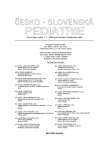Genetic Polymorphisms of UGT 1A1*28 in the TATA-box Promoter Region of Bilirubin Uridinediphosphate-glucuronosyltransferase Gene in Children with Gilbert’s Syndrome
Analýza UGT 1A1*28 polymorfismu v oblasti TATA-box promotoru genu pro UDP-glukuronyltransferázu u Gilbertova syndromu v dětském věku
Cíl:
Gilbertův syndrom (GS) je charakterizován chronickou nehemolytickou hyperbilirubinémií. Byly nalezeny mutace v promotorové i kódující oblasti genu UDP-glukuronyltransferázy (UGT 1A1). Molekulární epidemiologie a vlastní genetická podstata GS v naší dětské populaci není dosud známa. Naším cílem bylo stanovit frekvenci UGT 1A1*28 polymorfismu v promotorové oblasti genu pro UDP-glukuronyltransferázu (TATA-box mutace) v dětském věku a vymezit jeho využití v klinické praxi.
Metoda:
Polymerázová řetězová reakce (PCR) s detekcí zvýšení počtu TA sekvencí v promotorové oblasti genu pro UGT 1A1-TA(TA7)TAA u 53 pacientů s GS a 27 dětí v kontrolní skupině.
Výsledky:
Byly nalezeny následující genotypy: TA(6)/TA(6) (homozygot s normálními alelami nesoucí sekvenci [TA](6)TAA), TA(7)/TA(7) (homozygot s mutovanými alelami a sekvencí [TA](7)TAA) a TA(6)/TA(7) (heterozygot nesoucí mutovanou a nemutovanou alelu). Chlapci byli postiženi častěji než dívky (79,2 % vs. 20,8 %). Byly nalezeny statisticky významně rozdílné hladiny bilirubinu u pacientů s GS ve srovnání s kontrolami (p<0,001). Z 53 klinicky selektovaných pacientů s GS mělo 94,3 % homozygotní genotyp TA(7)/TA(7) a 5,7 % heterozygotní genotyp TA(6)/TA(7). Ze skupiny 27 kontrolních pacientů byla frekvence abnormální alely 51,9 %. Jeden pacient (3,8 %) měl genotyp TA(7)/TA(7), 13 pacientů (48,1 %) genotyp TA(6)/TA(7), u 13 pacientů (48,1 %) byl nalezen normální genotyp TA(6)/TA(6). Frekvence genotypu TA(7)/TA(7) v naší náhodně vybrané dětské populaci byla kalkulována 8 %.
Závěr:
TATA-box mutace mají významný vliv na sérovou hladinu bilirubinu. Homozygotní varianta TA(7)/TA(7)-box promotoru oblasti UGT 1A1*28 genu je silně asociována s GS především u dětských pacientů mužského pohlaví. Naše nálezy mohou mít důležitý význam v klinické pediatrické praxi u dětí s poruchami metabolismu bilirubinu.
Klíčová slova:
Gilbertův syndrom, UGT 1A1*28 polymorfismus, hyperbilirubinémie, TATA-box mutace
Authors:
J. Fremuth 1; J. Sýkora 1; Á. Bóday 2; F. Musil 3; J. Varvařovská 1; F. Stožický 1; K. Kotaška 4
; J. Schwarz 1; J. Skala 5
Authors‘ workplace:
Dětská klinika FN a LF UK, Plzeň
přednosta prof. MUDr. F. Stožický, DrSc.
1; Ústav biologie a lékařské genetiky 2. LF UK a FN Motol, Praha
přednosta prof. MUDr. P. Goetz, CSc.
2; Biolab, spol. s r. o., Laboratoř molekulární biologie, Klatovy
primář MUDr. F. Musil
3; Ústav klinické biochemie a patobiochemie 2. LF UK a FN Motol, Praha
přednosta doc. MUDr. R. Průša, CSc.
4; Dětské oddělení, Klatovská nemocnice, a. s., Klatovy
primář MUDr. J. Skala
5
Published in:
Čes-slov Pediat 2005; 60 (1): 7-13.
Category:
Original Papers
Overview
Aim:
Mutations in the promoter and coding region of the bilirubin UDP-glucuronosyltransferase gene (UGT 1A1) are known to be associated with Gilbert’s syndrome (GS), although the molecular epidemiology and basis for this syndrome in children has yet to be clarified. Authors aimed at evaluating the frequency of UGT 1A1*28 polymorphisms in the promoter region of the UDP-glucuronosyltransferase gene (the TATA-box mutation), and their clinical implications in GS.
Methods:
Analyses of the TATA-box mutations were performed in 53 patients with GS and 27 controls using PCR amplification.
Results:
Genotypes were assigned as follows: TA(6)/TA(6) (homozygous for a normal allele bearing the sequence [TA](6)TAA), TA(7)/TA(7) (homozygous for an mutated allele with the sequence [TA](7)/TAA), and TA(6)/TA(7) (heterozygous with one on each allele). Male patients (79.2%) tended to have GS more frequently than female patients (20.8%). There were significant differences in mean serum bilirubin levels between GS patients and controls (p < 0.0001). Of the 53 GS patients, 94.3% had homozygous TA(7)/TA(7) genotype, and 5.7 % had TA(6)/TA(7). Of 27 controls, the frequency of the abnormal allele was 51.9 %, one patient (3.8%) had TA(7)/TA(7), 13 had TA(6)/TA(7) (48.1%), and 13 (48.1%) had normal genotype TA(6)/TA(6). Calculated frequency of TA(7)/TA(7) genotype is 8% in the pediatric population.
Conclusion:
TATA-box mutations have a significant effect on serum bilirubin levels. Homozygous TA(7)/TA(7)-box variant of the promoter region of UGT 1A1*28 gene is strongly associated with GS predominantly in male Czech pediatric patients. These results have clear implications for clinical practice in children with disorders of bilirubin metabolism.
Key words:
Gilbert’s syndrome, UGT 1A1*28 polymorphisms, hyperbilirubinemia, TATA-box mutations
Labels
Neonatology Paediatrics General practitioner for children and adolescentsArticle was published in
Czech-Slovak Pediatrics

2005 Issue 1
- What Effect Can Be Expected from Limosilactobacillus reuteri in Mucositis and Peri-Implantitis?
- The Importance of Limosilactobacillus reuteri in Administration to Diabetics with Gingivitis
Most read in this issue
- Sad Facies, Spinal Malsegmentation, Progressive Vicious Kyphoscoliosis, Multiple Wormian Bones, Basilar Impression – A Novel Syndrome. Report of Two Sisters
- Genetic Polymorphisms of UGT 1A1*28 in the TATA-box Promoter Region of Bilirubin Uridinediphosphate-glucuronosyltransferase Gene in Children with Gilbert’s Syndrome
- Vascular Anomalies in Children – a New Classification System, Natural History and Treatment
- Unique Pattern Syndrome of Distinctive Facies, Short Stature, Kyphoscoliosis, Craniosynostosis, Hyperlaxity and Dyslexia
